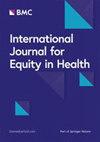健康差异对住院患者外周血管通路治疗效果的影响:一项观察性研究
IF 4.5
2区 医学
Q1 PUBLIC, ENVIRONMENTAL & OCCUPATIONAL HEALTH
引用次数: 0
摘要
置入外周静脉导管(PIVC)是医院的一项常规程序。研究的主要目的是探讨医疗保健不平等与 PIVC 结果之间的关系。本研究是一项多中心观察性分析,研究对象是 2021 年 1 月 1 日至 2023 年 1 月 31 日期间在美国密歇根州底特律市急诊科建立 PIVC 通道并需要住院治疗的成人。我们收集了流行病学、人口统计学、治疗、临床和结果数据。健康差异由美国国家少数民族健康和健康差异研究所定义。主要结果是PIVC停留时间占住院时间的比例,表示为停留时间(小时)占住院时间(小时)的比例 x 100%。在选择变量时使用了多变量线性回归和机器学习模型。随后,利用多变量线性回归分析来调整混杂因素,并对每个变量的真实影响做出最佳估计。在 2021 年 1 月 1 日至 2023 年 1 月 31 日期间,我们的研究分析了 144524 次急诊就诊,患者平均年龄为 65.7 岁,53.4% 为女性。种族人口统计显示,白人占 67.2%,黑人占 27.0%,其余为亚裔、美国印第安人阿拉斯加原住民或其他种族。PIVC住院时间与住院时间的中位比例为0.88,其中亚裔比例最高(0.94),黑人最低(0.82)。黑人女性的住院时间与住院时间比率中位数为 0.76,明显低于白人男性的 0.93(p < 0.001)。在控制了混杂变量后,多变量线性回归显示,黑人男性和白人男性的停留时间与停留时间之比分别比黑人女性高出 10.0% 和 19.6%(p < 0.001)。与白人男性相比,黑人女性面临的 PIVC 功能受损风险最高,导致她们的 PIVC 使用可靠性比白人男性低约一整天。为了全面解决和纠正这些差异,必须开展进一步的研究,以更好地了解医疗保健不平等对 PIVC 使用的临床影响。此外,还必须制定有效的策略来缩小这些差距,确保所有人都能获得公平的医疗保健结果。本文章由计算机程序翻译,如有差异,请以英文原文为准。
The impact of health disparities on peripheral vascular access outcomes in hospitalized patients: an observational study
Placement of peripheral intravenous catheters (PIVC) is a routine procedure in hospital settings. The primary objective is to explore the relationship between healthcare inequities and PIVC outcomes. This study was a multicenter, observational analysis of adults with PIVC access established in the emergency department requiring inpatient admission between January 1st, 2021, and January 31st, 2023, in metro Detroit, Michigan, United States. Epidemiological, demographic, therapeutic, clinical, and outcomes data were collected. Health disparities were defined by the National Institute on Minority Health and Health Disparities. The primary outcome was the proportion of PIVC dwell time to hospitalization length of stay, expressed as the proportion of dwell time (hours) to hospital stay (hours) x 100%. Multivariable linear regression and a machine learning model were used for variable selection. Subsequently, a multivariate linear regression analysis was utilized to adjust for confounders and best estimate the true effect of each variable. Between January 1st, 2021, and January 31st, 2023, our study analyzed 144,524 ED encounters, with an average patient age of 65.7 years and 53.4% female. Racial demographics showed 67.2% White, and 27.0% Black, with the remaining identifying as Asian, American Indian Alaska Native, or other races. The median proportion of PIVC dwell time to hospital length of stay was 0.88, with individuals identifying as Asian having the highest ratio (0.94) and Black individuals the lowest (0.82). Black females had a median dwell time to stay ratio of 0.76, significantly lower than White males at 0.93 (p < 0.001). After controlling for confounder variables, a multivariable linear regression demonstrated that Black males and White males had a 10.0% and 19.6% greater proportion of dwell to stay, respectively, compared to Black females (p < 0.001). Black females face the highest risk of compromised PIVC functionality, resulting in approximately one full day of less reliable PIVC access than White males. To comprehensively address and rectify these disparities, further research is imperative to improve understanding of the clinical impact of healthcare inequities on PIVC access. Moreover, it is essential to formulate effective strategies to mitigate these disparities and ensure equitable healthcare outcomes for all individuals.
求助全文
通过发布文献求助,成功后即可免费获取论文全文。
去求助
来源期刊

International Journal for Equity in Health
Medicine-Health Policy
CiteScore
7.80
自引率
4.20%
发文量
162
审稿时长
28 weeks
期刊介绍:
International Journal for Equity in Health is an Open Access, peer-reviewed, online journal presenting evidence relevant to the search for, and attainment of, equity in health across and within countries. International Journal for Equity in Health aims to improve the understanding of issues that influence the health of populations. This includes the discussion of political, policy-related, economic, social and health services-related influences, particularly with regard to systematic differences in distributions of one or more aspects of health in population groups defined demographically, geographically, or socially.
 求助内容:
求助内容: 应助结果提醒方式:
应助结果提醒方式:


